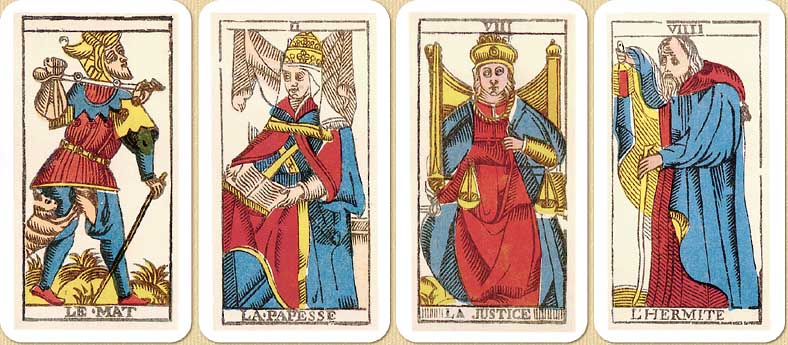Your Legal Resource
Marseilles Comparison - The Tarot Set By Thunder Bay Press
The Tarot Set
Thunder Bay Press, 2003
This set was published in 2003 by Thunder Bay Press under the unassuming title The Tarot Set. The book and deck come housed in a vertically oversized box that is sturdy and colorful. A purple velvet-like bag is also included for storing the cards. What caught my eye was the beauty of this Marseilles reproduction; I have several different Marseilles decks and this one ranks high on my list of favorites because of its rich color and the legibility of its lines. What sold me was its price tag of $12.98.
When I got this set home, I immediately compared its cards with those from other Marseilles decks I own, most of which are historical reproductions (yes, this tells you something about my obsession with antique decks!). The book identifies it only as a �Marseilles deck, a classic Italo-French design which remains one of the most popular worldwide.� Yet it is easy to see that these designs are taken from the same Conver woodblocks as are several other currently available deck reproductions, namely Lo Scarabeo�s Ancient Tarot of Marseilles, Heron�s Tarot de Marseille, and Camoin�s Bicentennial Tarot de Marseilles; a comparison between these decks is shown here.
After fuller comparison, I am convinced that this is a copy of a Camoin Bicentennial deck since its sizing, lines, and colors match those of the other. The stenciling of colors is also identical, which is unlikely to be the case if this was a reproduction of a different Conver edition. Finally, there are numerous breaks in linework that indicate varying stages of damage and age to the woodblock; these stages are evident in the different published editions, and those in this deck match the Camoin in spite of the detectable patching of linework by the publisher. Given that the Camoin is a direct printing from antique woodblocks rather than a modern Marseilles recut, I assume that Thunder Bay Press used its images as a means of getting around copyright restraints. In any case, their reproduction is very good, and in some ways preferable to the Camoin: the paper stock conveys a slightly sharper contrast, with darker blacks and brighter colors, and the cards are laminated. (On the other hand, the Camoin was printed directly from antique woodblocks onto beautiful, unlaminated cardstock. Its ink coverage is also far smoother, as opposed to the mottled coverage in this reproduction.) In light of the expense and scarcity of the Camoin printing, I consider this new version a much-needed and attractive Marseilles.
The book which comes with the set is titled The Illustrated Book of Tarot, written by Jane Lyle who has authored several books on Tarot. This one begins with a very brief (four-page) overview of the Tarot. Although there are some historical inaccuracies here (such as �What seem to be the earliest existing Tarot cards, of which 17 remain, date from 1392.�), they are few and not really germane to the book�s function, as virtually the entire book deals with card interpretation and layout. The book is illustrated by cards from both the Waite-Smith and Marseilles decks, and even includes some color plates of other antique cards and Tarot-relevant artwork.
During the last few decades, books illustrating the Marseilles Tarot have primarily shown the version by Grimaud - the version with which Tarotists are probably most familiar. It is nice to now see the Conver Marseilles coming into vogue since I consider its engravings to be somewhat more elegant.
It is also surprising to see the Marseilles Tarot featured in a set aimed at the popular audience, especially a set presented as a divinatory tool. In my opinion, this is a step toward a broader understanding of the Tarot, given a field in which modern designs - most notably the Waite-Smith and Crowley - seem to predominate.
Those unfamiliar with the Marseilles designs may be surprised to find here the source for much of the Waite-Smith imagery. The caduceus and winged lion showed above the chalices in the Two of Cups, for instance, derives from the heads which rise sinuously in Marseilles versions of the card (the Marseilles, however, usually depicts these as dolphins rather than as lions). In the Aces, the hands which emerge god-like from the clouds derive from the Marseilles, though its design does not depict hands grasping the �receptive� suit symbols of Cup and Coin. The �yuds� or flame-like shapes in the Ace of Wands and Ace of Swords are also there in the earlier pattern. The Waite-Smith Two of Coins alludes to the figure-eight band around the Marseilles coins. The Marseilles Seven of Coins depicts one coin encased like a seed inside a floral blossom, intimation pictorialism by the Waite-Smith image.
This entire set is priced at less than most single decks on the market today, and it is beautifully produced as well.
